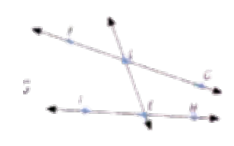An electronic assembly consists of two sub-systems say A and B. From previous testing procedures, the following probabilities are assumed to be known. P(Afails)=0.2,P(Bfailsalone)=0.15,P(AandFail)=0.15. Evaluate the following probabilities: P(Afails/Bhaailed) (ii) P(Afailsalone)
The correct Answer is:N/a
Let the events that A and B fails are represented by A' and B' respectively.
P(A')=0.2,P(A'∩B')=0.15
∵P (B fails alone)=P(B')−P(A'∩B')
⇒0.15=P(B')−0.15⇒P(B')=0.30
(i) P (A fails /B fails)
=P(A'/B')=P(A'∩B')P(B')=0.150.30=0.5
(ii) P (A fails alone)
=P(A')−P(A'∩B')=0.2−0.15=0.05
Topper's Solved these Questions
- PROBABIILITYBOOK - NAGEEN PRAKASHAN ENGLISHCHAPTER - PROBABIILITYEXERCISE - Exercise 13.5
15 Videos
- MATRICESBOOK - NAGEEN PRAKASHAN ENGLISHCHAPTER - MATRICESEXERCISE - Miscellaneous Exerice
15 Videos
- RELATIONS AND FUNCTIONS BOOK - NAGEEN PRAKASHAN ENGLISHCHAPTER - RELATIONS AND FUNCTIONS EXERCISE - Miscellaneous Exercise
19 Videos
Similar Questions
An electronic assembly consists of two sub-systems say A and B. From previous testing procedures, the following probabilities are assumed to be known. P(A fails)=0.2, P(B fails alone)=0.15, P(A and B Fail )=0.15. Evaluate the following probabilities: (i)P(A fails/B has failed ) (ii) P(A fails alone)
View SolutionCheck whether the following probabilities P(A) and P(B) are consistently defined(i) P(A)=0.5, P(B)=0.7, P(A∩B)=0.6(ii) P(A)=0.5, P(B)=0.4, P(A∪B)=0.8
View SolutionCheck whether the following probabilities P(A) and P(B) are consistently defined
(i) P(A)=0.5,P(B)=0.7,P(A∩B)=0.6
(ii) P(A)=0.5,P(B)=0.4,P(A∪B)=0.8
View SolutionFind the mean and standard deviation of the following probability distribution: xi:2 3 4 pi:0.2 0.5 0.3
View Solutionusing s, p, d notations describe the orbtal with the following quantum numbers .
(a) n = 2 l=1, (b) n = 4 , l = 0, (c) n= 5 , l=3 , (d) n = 3 , l = 2
View SolutionIf A and B are two independent events and P(A)=0.2,P(B)=0.3, then find the values of the following:
(i) P (A and B) (ii) P (A and not B)
(iii) P (A or B) (iv) P (none of A and B)
View SolutionIn the given figure . Which of the following are non collinear points ?
L and E
(b) F.L and G
( c ) I. E and H
(d) F.L and E

View SolutionUsing s, p and d notations, describe the orbitals with following quantum numbers :
(a) n=1,l=0 , (b) n=2,l=0
(c) n=3,l=1 , (d) n=4,l=2
View SolutionLet R be a relation from N to N defined by R={(a,b):a.b∈Nand a=b2). Are the following true?(i) (a,a)∈R,foralla∈N(ii) (a,b)∈R,implies(b,a)∈R(iii) (a ,
View SolutionUsing the s,p,d,f notations, describe the orbitals with the following quantum numbers,
(a) n=1, l=0 (b) n=2, l=1
(c ) n=3, l=0 (d) n=4, l=3
(e ) n=5, l=2
View Solution
